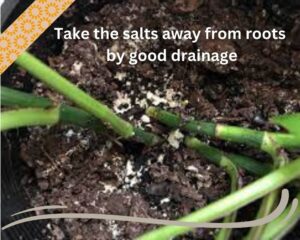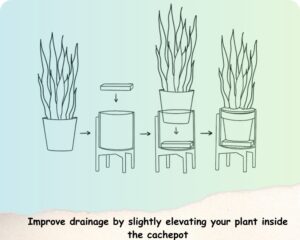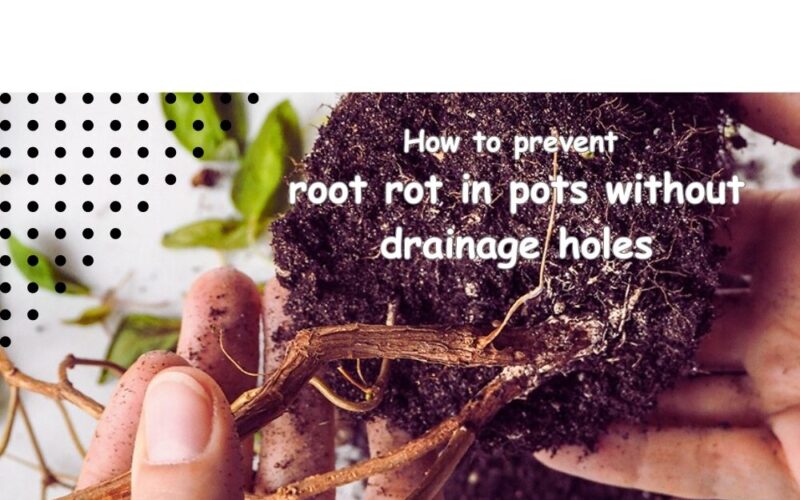Here you will find best practices to prevent root rot in pots without drainage holes. After reading this article you can plant in a cachepot without any worry.
In previous articles, we talked with you about the advantages of planting in a pot without holes (read “Why do some plant pots not have holes?”), however, there is a concern about root rot risk in planters without holes.
Root rot is one of the critical risks for all plants and usually will cause the death of the plant.
Hence in the present article:
- First, we will discuss the importance of drainage in plant pots.
- Then, I will show you 10 practical ways that help you to decrease the risk of root rot in pots without holes.
If you are ready let’s start.

What happens if my pots don’t have drainage holes?
A drainage hole is one of the ways (indeed the best way) to create drainage in plant pots. But if your planter doesn’t have them, you have to create drainage in your container with other ways to prevent root rot. To find out the importance of this issue let’s know more about the role of drainage in your pot.
What do you mean by drainage? Drainage is removing a liquid from a surface or undersurface of an area. In your planter, this liquid is water and you have to remove it from the potting soil. why? keep reading.
Root breathes.
The roots are like the foliage parts of your plant, take oxygen from the soil and release carbon dioxide there. root exchange these gases in the holes of the soil. without drainage, after a huge watering the soil’s hole will fill with water and roots will drown in water. So, if you cannot take away the extra water around the roots, they will suffocate.
Airflow in soil.
Airflow inside the soil will improve the root system and cause the plant to extend its roots. If the holes of the soil fill with water, the airflow inside the soil will be stopped and your plant will have a weak root system.
Accumulation of salts:

While watering with tap water and fertilizing, you add salt to the soil. During this time, the salt will accumulate in the soil and will poison the roots. Drainage removes salts from the soil.
All of the above factors (low oxygen to breathe, lack of enough air flow and accumulation of salts in soil) will cause your plant roots to get weak and weaker and get sensitive to aggressive fungi and Bactria. Hence you will spot the root rot symptoms in your plant.
Now, you found out the importance of drainage. As mentioned above, the holes in the bottom of planters are one of the critical ways to create drainage, but if your pot doesn’t have them, how can you prevent root rot? Keep reading to tell you the following.
Practical ways to prevent root rot in pots without drainage holes
In this part, I will show you how to create drainage in pots without holes.
Get help from double pot method
If you ask me, it is the best way to create drainage in the soil. your plant will grow in a nursery pot with enough drainage holes and you put it inside a cachepot to take advantage of a pot without holes. The risk of root rot will decrease with this method.
You can improve drainage by slightly elevating your plant inside the cachepot. you can do it with a wood plank or Styrofoam block (as you can see in the following picture). In this situation, if you add a lot of water (overwatering), the roots never stand in water.

In the following you can find other advantages of this method:
- It is a very easy way to improve drainage along with having an aesthetics visual.
- You can take the nursery pot out of the decorated pot and shower your plant in the sink without any mess.
- When you spot the roots that are coming out of the holes of the nursery pot, it means you must repot it. Repotting is very easy without the risk of breaking the decorated pot.
Build a depot at the bottom of the pot.
Another way to create drainage in pots without holes is by putting drainage rocks or grovels in the bottom of your planter. You should fill ¼ of the pot with rocks to make a separation between the roots developing area and extra water.

In this way, the extra water will accumulate in the rock depot, however, if you have a heavy hand in watering or as the root system extends through the soil, the extra water and roots may meet each other and increase the risk of root rot.
Water your plant sparingly and slowly.
When your planter doesn’t have drainage holes, the water will accumulate in the soil, if you water your plant slowly, you let the water spread through the soil and you don’t need to add a lot of water to it. hence you will prevent root rot.
Improve the soil texture
One of the important factors in increasing the risk of root rot is planting in compacted soil. water cannot move easily in compacted soil and hence will accumulate in the root living space. It will be highlighted in pots without holes.
To have light soil you should add the below additives to the soil:
- perlite
- pumice
- vermiculite
- orchid bark
- horticultural charcoal
Add a layer of activated charcoal
You should After adding drainage rocks, add a thin layer of Activated charcoal too. because it can absorb the extra water and additionally have antimicrobial activity. Hence, it works as a bonus in your pot that prevents root rot.
Spill out the extra water to prevent root rot
if you are worried about overwatering, tip your pot to the side till the extra water spill out. You may lose a few soils, don’t, worry and add it later.
Avoid placing your pot in outdoor
If you place your pot outdoors, the rain will work as an overwatering and will cause root rot in pots without drainage holes.
Plant in taller pots.
When you plant in tall pots instead of wide ones, there is more distance between the accumulated water in the bottom of the pot and the root living area.
Seek the sign of root rot

When you plant in a pot without holes you should always consider the symptom of root rot such as losing vigour, yellowing, soft stem, etc. If you spot these symptoms, you should repot your plant and check the roots.
Get help from plants that can thrive in pots without holes.
Some plants can grow in containers without drainage holes. You must plant them in your planter to decrease the risk of root rot. Read the following articles and make your list from your favourite indoor plants:
- Flowers that don’t need drainage holes
- What hanging plants don’t need drainage?
- Herbs that don’t need drainage
- Succulents that don’t need drainage
- Small indoor plants without drainage holes.
Build A Drainage Hole by drilling
If you failed in the above policies, the best way to prevent root rot is you create holes by drilling. Doing it professionally to avoid breaking your beautiful cachepot
Conclusion
Now you found out the importance of drainage in indoor plants and learned how to prevent root rot in pots without holes. We showed you 11 tips that help you to improve drainage and take out extra water from roots. Do you have any experience in planting in planters without drainage holes? Do you think the above tips will work well? Can you add new tips to our list? Please share your experience and knowledge with our readers below this page.

Elahe Rabiei
Hi, I’m Elaheh. My Academic major is plant protection, and houseplants are my expertise. As a houseplant lover, my house is full of indoor plants and it is my passion to take care of them. Hence, I’m here to share my knowledge and experience about growing healthy houseplants. I am also a plant protection advisor, so feel free to ask me any questions you may have.

